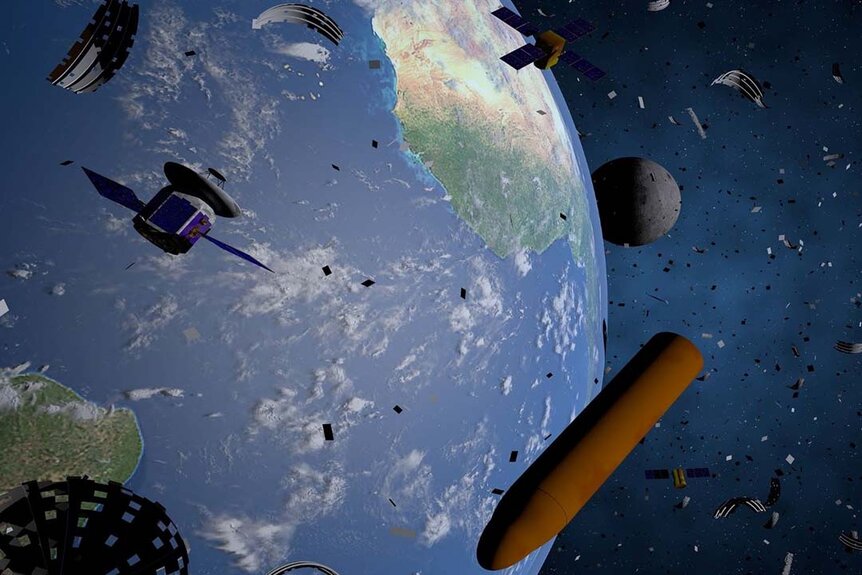Create a free profile to get unlimited access to exclusive videos, sweepstakes, and more!
Secret Russian satellite broke up in orbit, creating debris field that could last a century
Space Force is tracking 85 pieces of debris expected to remain in orbit for a century.

In Battlefield Space (now streaming on Peacock!), NBC correspondent Tom Costello takes viewers inside some of the operational facilities of the United States Space Force, the latest addition to the U.S. Military. In just under an hour, he provides a window into the mission and activity of the world’s first and only dedicated independent space force.
U.S.S.F is tasked with operating 77 spacecraft at various altitudes from low-Earth orbit to geosynchronous GPS satellites in mid-Earth orbit. They also operate the U.S. space surveillance network, which is responsible for tracking debris in the space around our planet. On Feb. 6, the 18th Space Defense Squadron — a part of Space Delta 2, the arm of Space Force responsible for Space Domain Awareness — reported the breakup of a mysterious Russian satellite dubbed COSMOS 2499. According to a tweet from the 18th SDS, the breakup occurred on Jan. 4 and resulted in at least 85 pieces of debris at an altitude of approximately 726 miles (1169 kilometers).
RELATED: Space Force's Chimpanzee episode builds on a rich, deadly history of animals in space
The mysterious COSMOS 2499 launched in May of 2014, along with three communications satellites. While Russia made public the launch of the first three devices, the appearance of a fourth satellite was a surprise which led to some speculation as to its purpose. In fact, it wasn’t the first time Russia had launched a secret satellite and it wouldn’t be the last. A total of three secret payloads were deployed between 2013 and 2015, two of which have now met a destructive fate.
Concerns about COSMOS 2499 redoubled when the satellite began performing unusual maneuvers, including making close approaches with other Russian satellites nearby. The way it moved and the secrecy behind its launch has led some to suggest COSMOS 2499 may have been a prototype space-based weapons system designed to disable or damage orbiting satellites. That, of course, is the sort of thing Space Force is interested in, though they made no comment about the purpose of COSMOS 2499 or the nature of its destruction.
According to Oleg Ostapenko, then-head of Roscosmos, COSMOS 2499 and the other secret satellites didn’t have nefarious purposes and were instead educational devices which completed their mission after about six months in space. We may never know their true purpose and the reason it transformed into several dozen pieces of space shrapnel is equally mysterious.
It’s possible the satellite was struck by space junk or a micrometeor, that’s certainly happened before, but some have suggested that COSMOS 2499’s destruction might have a more terrestrial explanation. One destroyed satellite can be a coincidence, but COSMOS 2491 — another secret satellite launched a few months before COSMOS 2499 — met a similar fate in 2019. Two destroyed satellites, both shrouded in mystery, is a little harder to explain away. In a statement to ArsTechnica, space debris expert Brian Weeden said he sees a pattern.
"This suggests to me that perhaps these events are the result of a design error in the fuel tanks or other systems that are rupturing after several years in space rather than something like a collision with a piece of debris," Weeden said.
Authorities are currently tracking the 85 pieces of debris shed by COSMOS 2499 to ensure they don’t cause any problems for other space-based assets in the area. At present, it’s believed that the debris doesn’t pose an immediate threat, but they do add to the growing problem of space junk.
RELATED: Odds are way better than you think that space junk could kit a person within a decade
According to NASA, the Space Surveillance Network is tracking more than 27,000 pieces of orbital debris, and those are only the pieces large enough to be tracked. There are countless other pieces in orbit which are too small for us to keep tabs on but still large enough to damage spacecraft.
They also estimate that debris orbiting at an altitude of more than 620 miles (1,000 kilometers) will remain in orbit for a century or longer unless we go out there and clean it up ourselves. Ironically, the sorts of machines which could address the space junk problem would likely behave a lot like COSMOS 2499, maneuvering up to objects in orbit and capturing them or knocking them into the atmosphere. Of course, if the Russians were developing orbital street sweepers, they might not be so secretive about it.
Learn more about how Space Force and other organizations are operating in space and how they might operate in the future, in Battlefield Space, streaming now on Peacock!



























